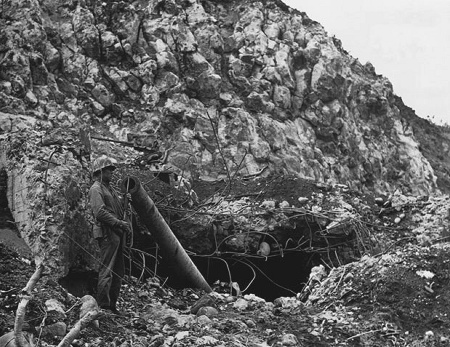[On this day a big Japanese artillery piece was finally located and taken out of action.]
Others have written about the sound of incessant artillery, and how men, especially desperately tired men, can tune it out and get decent sleep in their cozy holes. It seems the Japanese commanders have been keeping up with the literature on the subject. The nighttime artillery focused on American troops and equipment has been just that – focused. The rounds are either spread along the lines, or the obvious places one would want to set up overnight defensive lines from our side of things, or concentrated on an actual cluster of tents or an equipment dump that was observed setting up during the day. The timing is stubbornly inconsistent, but few that I talk to think it’s random.
There are always precautions against making light at night which can draw enemy fire. In this position the rules are especially strict. There’s no hope of getting a double tent with a blackout lock set up this close to front, let alone a single tent. Everyone is dug down into the earth, as far as they can get into the rocky hillside. I am rushing to get my notes written out before complete darkness overtakes the southeastern face of this mountain.
I am with the 40th Infantry Division, near Kanoya on the first (southern) slope of the multi-ridged mountain they call Onogara-dake. Yesterday our 108th Regiment moved through Kanoya to be the first Americans to touch the precious waters of Kagoshima Bay. Today the division’s other regiments, the 160th and 185th, attacked up the first ridge face of Onogara-dake and now hold it. It was not cheap – a steady parade of stretcher bearers still working their way down the hill is ready testament to the price – but there was a prize in this box of explosive Cracker Jacks. The position of one very heavy gun that has been firing on the beach, and everywhere else for a dozen mile radius, was taken and silenced for good.
It was known that some of the Japanese navy cruisers and older battleships have had their gun turrets removed, since for a year now it has been all but impossible for a Japanese capital ship to leave port and succeed at any military purpose. Not that our submarines or bombers or navy gunners care about the purpose – they are attacked and sunk on sight. Several Jap ships have been put down in harbors while already toothless relics. It was supposed that the turrets were melted down to make other more needful things with the steel, but some wondered about the guns.
Major Benjamin Davis of the 160th Regiment staff tells me it was an eight inch gun, they’re not sure how old. It’s larger than anything the Japanese army lugs around, and dragging it up to its hole in the mountain had to be a mean feat, along with fitting out the hole. The gun could be taken back in out of sight after firing. “We didn’t see the cave, which we think was hand dug, until about 200 yards away. It was already abandoned, but a pair of machine guns was left waiting for us to approach and check it out. They had the thing on tracks, with a manual traverse that was slow, but worked. It was right under a natural brow in the hill, with brush around it, some of it drug there recently. The whole thing looked like nothing but a dark spot on the hill, on a sunny day. Oh, they had other shallow painted fake cave entrances scattered around it. One of them we pounded with 155s and rockets for days, just a hundred yards away – for nothing.”

